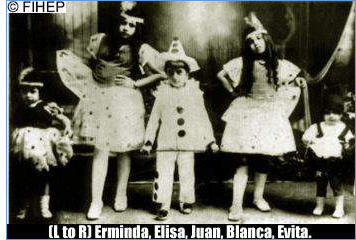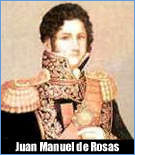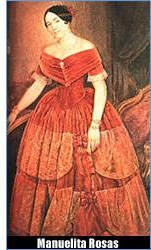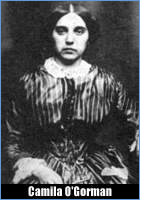From earliest
childhood, Evita loved to entertain. She and her sister Erminda would
organize their own circus in the  backyard
of the house where they spent their childhood in Junín; they were the
clowns who rubbed wet crepe paper on their faces for color and the acrobats
who balanced precariously on a pipe held up by two sawhorses or swung
from a makeshift trapeze until Erminda fell and split her head open and
their mother put an end to their circus performances.1 backyard
of the house where they spent their childhood in Junín; they were the
clowns who rubbed wet crepe paper on their faces for color and the acrobats
who balanced precariously on a pipe held up by two sawhorses or swung
from a makeshift trapeze until Erminda fell and split her head open and
their mother put an end to their circus performances.1
When
she was still in elementary school, Evita showed the same generosity of
soul which would one day lead her to spend eighteen hours at a time attending
to the poor. She and her sister Erminda visited a paralyzed and homebound
woman each day after school. Evita, "a whirlwind of movement,"2 would sing, dance, pirouette, make clown faces and for a half hour or
so transform the woman's dreary house into a stage echoing with laughter
and applause.
Evita's teachers recalled that on rainy days when attendance was poor,
Evita would ask permission to go to the lower grades and entertain the
children with stories, songs and poems. 3
When her sister Erminda began secondary school, she joined the school's
Cultural and Arts Center. Through the intercession of Erminda, Evita was
given a role in the plays the students produced. Her joy at being on a
real stage was indescribable and she felt that at last her dream was becoming
a reality.4
Feeling the stage under her feet and drinking up the approbation of a
real audience made Evita even more determined not to postpone her dream
until she had finished secondary school. She wanted to make her way in
the real world, but her mother wanted her to finish her studies. Her older
sister Blanca describes the family conflict Evita's dream caused:5
"By this time, with the help of Elisa's job at the post office, Juan's
job, and my teaching position, Mother was able to rest a little from her
fatiguing work as a seamstress. Thus my family lived in Junín. The years
went by and Juan was drafted into the Army. He was sent to Buenos Aires.
During the afternoons in Junín, Prime Ariní's Music Store set up loud
speakers on the street corner outside the shop. For the first time Eva's
voice was broadcast over the airwaves. She recited a wide repertoire of
poems with the same conviction and professionalism which would later help
her to conquer the Capital as an actress. Even as a child, she had shown
remarkable artistic talent. In the beginning we believed that her desire
to be an actress was only a childhood dream. But her stubbornness in fighting
for her dream led to lots of problems at home. Mother's opposition to
Eva's dream was rooted in her desire to protect her child.
"Eva wanted to travel to Buenos Aires to participate in an amateur talent
show. No one could dissuade her. She showed the same iron will and determination
which would mark her for the rest of her life. She insisted and insisted.
"At first Mother's response was ABSOLUTELY NOT. Then Doctor José Alvarez
Rodriguez, Rector of the National School of Junín, intervened.
"Dr. Alvarez Rodriguez's advice was that parents have no right to thwart
their child's vocation.
"If the child has talent you must let her try her wings; if she does not,
you will return home happy that you supported her.
"I can still remember Mother's irritation and the climate of nervousness
and sadness that prevailed in our house on the day our mother accompanied
Eva to Buenos Aires. Eva, however, was confident and serene.
"That evening Elisa, Erminda and I listened to the radio program which
paid homage to the city of Bolivar. Were we ever surprised to hear Eva's
voice! She was reciting the poem by Amado Nervo, "Where Do the Dead Go?"
Everything went so well that Pablo Osvaldo Valle, director of the station,
called her and Mother into his office and offered Eva a small contract;
this contract made it necessary for her to stay in Buenos Aires.
"Mother returned alone to Junín, furious with the Rector, furious with
everyone.
"From then on, Eva only returned to Junín for someone's birthday or if
one of us was ill. She worked tirelessly to conquer the Capital and shared
those early days in Buenos Aires with our brother, Juan. Later, in 1936,
my sister Elisa married Major Alfredo Arrieta and they went to live in
Buenos Aires. At last Eva had more family members with her and Mother
was more tranquil and content. "
By May of
1939 Evita and Pascual Pelliciotta were the heads of a company, el Teatro
del Aire, which began broadcasting a radiotheater historical romance written
by Héctor Pedro Blomberg. "After four years of incessant struggle and
continuous disillusion, the moment had arrived: Antena published
her photo, a well-known author wrote an original script for her and she
had her own company. A few days after the beginning of the broadcasting
of Los Jasmines del Ochenta, the first play Blomberg wrote for
her, Evita had her twentieth birthday." 6
Héctor Pedro Blomberg wrote about a period in Argentina's history which
was just as controversial as the  Peronista
epoch would later become: the 19th century when Juan Manuel de Rosas,
the Restorer of Law and Order, ruled over an Argentina divided into "unitarios"
and "federales". In Argentina, Rosas and his times are still seen by liberal
historians as "cursed." Rosas was an authoritarian figure who did not
hesitate to shoot or persecute his enemies... any more than the "unitarios"
did when they were in power. In 2001, the Argentine historian Pacho O'Donnell
wrote that during the time of Rosas, " anarchy, fratricidal war, the dismemberment
of the country and the dissolution of institutions reigned. Rosas, lover
of order, governed with harshness and astuteness in favor of his friends
who owned estancias and the people, and against the financial speculators,
the Frenchified intellectuals and those who did not respect country or
religion. Peronista
epoch would later become: the 19th century when Juan Manuel de Rosas,
the Restorer of Law and Order, ruled over an Argentina divided into "unitarios"
and "federales". In Argentina, Rosas and his times are still seen by liberal
historians as "cursed." Rosas was an authoritarian figure who did not
hesitate to shoot or persecute his enemies... any more than the "unitarios"
did when they were in power. In 2001, the Argentine historian Pacho O'Donnell
wrote that during the time of Rosas, " anarchy, fratricidal war, the dismemberment
of the country and the dissolution of institutions reigned. Rosas, lover
of order, governed with harshness and astuteness in favor of his friends
who owned estancias and the people, and against the financial speculators,
the Frenchified intellectuals and those who did not respect country or
religion.
"The vengeful obstinacy of his detractors has obscured the epic defense
he waged against the attacks of the two superpowers of the time, England
and France. In spite of them he was able to maintain the integrity of
[Argentine] territory and his exaltation of the concept of "sovereignty"
won him the admiration of our Liberator, General San Martin, who bequeathed
his precious sword, symbol of American independence, to Rosas." 7
Blomberg was known for incorporating historical themes into his songs
and plays. Natalie Pepa says that Blomberg's " La Pulpera de Santa Lucia,"written
in 1929, " is one of the most beautiful and melodious of porteño waltzes...
an instant success which has remained one of the most popular waltzes
to this day... . "Aside from its  lovely
melody, the words tell a story set in a real place during historical times.
The parish of Santa Lucia does exist; it is a chapel in Buenos Aires located
... in the neighborhood of Barracas [and] the events surrounding the fictional
story are real. "The 1840's were a period of great turmoil in Argentina.
Civil war had erupted as the rebel troops attempted to overthrow the government
of Juan Manual de Rosas... . The troops of Rosas, distinguished by their
red tunics, were called Mazorqueros. They imposed terror ... . " 8 lovely
melody, the words tell a story set in a real place during historical times.
The parish of Santa Lucia does exist; it is a chapel in Buenos Aires located
... in the neighborhood of Barracas [and] the events surrounding the fictional
story are real. "The 1840's were a period of great turmoil in Argentina.
Civil war had erupted as the rebel troops attempted to overthrow the government
of Juan Manual de Rosas... . The troops of Rosas, distinguished by their
red tunics, were called Mazorqueros. They imposed terror ... . " 8
Blomberg romanticized the era of Rosas, not Rosas himself.Blomberg's
primary school reader Pensamiento, published in 1925, paints Rosas as
a cruel tyrant. However, even liberal historians respected Rosas' daughter
Manuelita who often interceded and obtained mercy for Rosas' enemies.
"Manuelita's name,"Blomberg says, "will always be in the hearts of Argentines" 9 and he praises her for her loyalty to her father.
Sadly, the one time when Manuelita most wanted to move her father to pity,
she failed.
Camila O'Gorman, nineteen, and her parish priest, Uladislao Gutiérrez,
thirty, fell in love. In 1847, they ran away from Buenos Aires to the
province of Corrientes where they established a school. Some months later
they were recognized, captured, returned to Buenos Aires and imprisoned.
Manuelita wrote Camila a letter in which she told her to be strong and
promised to intercede for her before Rosas. She also purchased furniture
for Camila's cell. Rosas said that he was under fierce pressure to make
an example of the lovers so that others would not think that the scandal
would have no serious consequences. Even though Camila was pregnant, both
she and Gutiérrez were  shot
the day after they were returned to Buenos Aires. The horror of this execution
reverberated throughout the country and haunted Rosas. In perhaps the
last letter he wrote, he shows that..."the death of Camila perturbed him
until the end of his days." 10 shot
the day after they were returned to Buenos Aires. The horror of this execution
reverberated throughout the country and haunted Rosas. In perhaps the
last letter he wrote, he shows that..."the death of Camila perturbed him
until the end of his days." 10
Blomberg did not tackle the drama of Camila. The second script that he
wrote for Evita's company was called "Las Rosas de Caseros." Rosas' troops
were defeated by the unitarios under Urquiza at the battle of Caseros
on February 3, 1852. Rosas and Manuelita escaped to England. Their property
was confiscated and they never returned to Argentina. They felt the bitterness
of their exile but they did go on with their lives. Manuelita married
her childhood sweetheart and had two sons. Rosas bought a farm and turned
it into a replica of an Argentine estancia. Back in Argentina, as is always
the case, the victors showed no mercy towards the vanquished. In "Las
Rosas de Caseros," set in the tumultuous days after the fall of Rosas,
Evita played the part of Adriana Pacheco, a young woman torn between two
loves, one federal, the other unitario (the equivalent of being torn between
a Northerner and a Southerner in the American Civil War).
Evita did not swallow the official story of Rosas as the archvillain of
Argentine history. In 1950, when she was the wife of the President, a
young historian named Fermin Chavez told her that it was a disgrace that
the liberal textbooks which painted Rosas as a villain had not been revised.
"Her political responses never ceased to surprise us, especially since
they ran contrary to what popular opinion believed them to be. Thus, when
on one occasion we presented her with the problem of teaching "official"
history, which we thought deformed, and which continued unchanged under
the Peronista government, she responded immediately, 'You are right. I
think, as you do, that Rosas was not what he is said to be... . But if
we state this problem now, we will divide Peronism.' In truth, that was
the answer best suited to the real world of 1950 11 [when] [t]he immense majority of the leaders of the Peronista
Party came from the most rancid Argentine liberal tradition, as did its
representatives in Congress and its Cabinet functionaries." 12
The Chavez anecdote shows that Evita was always able to think outside
the box and form her own opinions.
Duarte
de Bertolini, Erminda. Mi Hermana Evita. Buenos Aires: Centro de
Estudios Eva Perón, 1972. pgs. 34,35.
Bertolini,
pg. 41.
Navarro,
Marysa. Evita. Buenos Aires: Corregidor, 1981. pg. 26.
Bertolini, pg. 68.
See
"Our True Life" on this website, click here.
Navarro,
pg. 46
O'Donnell,
Pacho. Juan Manuel de Rosas. Buenos Aires: Planeta, 2001.
Pepa, Natalie. "La Pulpera de Santa Lucía". http://www.tangonoticias.com
Blomberg, Hector Pedro. Pensamiento. Buenos Aires: Angel Estrada,
1925. pg. 81.
O'Donnell,
pg. 241.
Chavez,
Fermín. Eva Perón Sin Mitos. Buenos Aires: Ed. Theoria, 1996. pgs.
130-131.
Chavez,
pgs. 137-138. |
